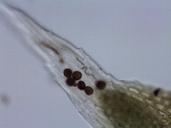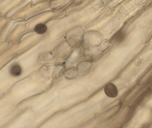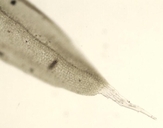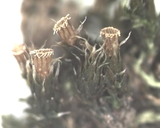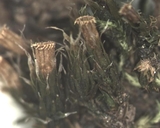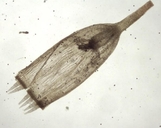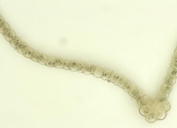- Map Distribution
- Description
- eFlora Distribution
- Illustrations
- Cal Photos images
- Elevation by latitude plot
MAP CONTROLS
1. You can change the display of the base map and layers by clicking on the layer control box in the upper right-hand corner.
2. California county polygons can be turned off and on in the layer control box.
3. Filling of Jepson subdivision polygons can be turned off and on in the layer control box.
Database links
UC Specimens in the University and Jepson Herbaria Public Portal
Specimens of Orthotrichum diaphanum in the Consortium of North American Bryophyte Herbaria portal (CNABH)
Orthotrichum diaphanum, Musc. Rec. 2 (2): 29. 1801. -- Orthotrichum garrettii Grout & Flowers in Grout, Moss Fl. N. Am. 2: 128. 1935.
Plants to 0.6 cm high, erect in minute green to yellow-green tufts. Leaves ascending to erect when moist but loosely appressed when dry, lanceolate and broadest near the base, to 2.5 mm long, 3–4: 1, with the acuminate apices bleached to hyaline in a well-demarcated region. Median laminal cells isodiametric to transversely elongate with rounded lumens, thick walled with strong corner thickenings, to 18 µm wide, smooth or occasionally with 1–2 low and unbranched papillae on each surface. Basal marginal cells smooth and quadrate, pellucid. Basal juxtacostal cells mostly smooth, short rectangular, 1.5–3: 1, with lateral walls straight and with uniform thickening. Margins recurved nearly to base of awn, entire below but serrulate on awn. Costa ending near the base of the awn, not placed in a sharply defined abaxial keel. Costa cross-section nearly terete, essentially homogeneous, mostly 3 cells thick, and 4–6 cells wide along the abaxial perimeter. Lateral axillary hairs to 3 cells and 75 µm long with one basal brown cell; central axillary hairs mostly about twice as long, not offset from leaf insertion. Rhizoids clustered near base of plant, smooth and thin-walled, red-brown, to 25 µm in diameter at base, repeatedly branched. Stem cross-section rounded pentagonal, with no central strand, with leptodermous and hyaline inner corticals and with 3–4 layers of strongly pachydermous, red brown outer cortical cells. Gemmae abundant in leaf axils, inserted on lower lamina, mostly uniseriate and 6–8 celled, to 125 µm long.
Autoicous with perigonia in leaf axils near the perichaetia. Perichaetia terminal with bracts similar to the vegetative leaves. Capsule immersed on a yellow to yellow brown, smooth and erect seta up to 0.5 mm in length. Urn orange-brown, to 0.8 mm long, about 2: 1, erect, smooth to lightly sulcate with eight ribs, lightly to not at all strangulate. Operculum conic-apiculate. Annulus well-defined, revoluble. Exothecial cells at capsule mouth strongly reddened, to 15 µm long, isodiametric to transversely elongate with rounded lumens in up to 4 rows. Exothecial cells at middle of urn quadrate to rectangular, 1–1.5: 1, to 20 µm broad, very thick walled on ridges of capsule with lumen: wall ratio 0.25–1: 1, thinner walled in valleys of the sulcate capsule. Stomata mostly on proximal 1/3 of urn, cryptoporous, only partially obscured by subsidiary cells. Exostome teeth 16, occasionally paired in freshly deoperculated capsule, pale to almost white, to 200 µm long, finely and densely papillose-striate. Endostome segments mostly 16, nearly as long as exostome, densely papillose, arising from one or two rows of cells. Calyptra campanulate and plicate, glabrous or with a few smooth hairs. Spores to 16 µm, rather coarsely papillose.
Vouchers: Alameda Co.: UC Berkeley Campus, Norris 100334; Los Angeles Co.: Memorial Park, Claremont, Harpel 890 (pers. herb.); San Bernardino Co.: Paris Hill City Park, City of San Bernardino, Harpel 1688 (pers. herb.); San Diego Co.: El Monte Road about 1 mile east of El Monte Park, Norris & Piippo 82150 and San Clemente Canyon at Genesee Road, City of San Diego, Norris 50712; San Francisco Co.: Panhandle, Golden Gate Park, Toren 7795 (CAS) and Shevock 18931; Santa Cruz Co.: San Lorenzo Park, City of Santa Cruz, Kellman 967 (CAS).
Literature: Kellman 2003; Shevock and Toren 2001.
Geographic subdivisions for Orthotrichum diaphanum: CW, SW. |
Illustration References: Malcolm et al. 2009 p. 206; Ignatov and Ignatova 2003; Lewinsky 1984; Sharp et al. 1994; Smith 1978; Vitt 1973.







